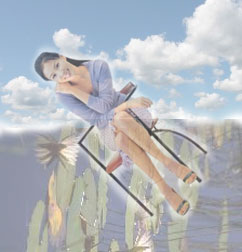Feng Shui for a
Happier Home
PAGE 1 OF 2
Wise placement of your rooms and furnishings will help your family enjoy more health and prosperity.
by Tina Ma
GOLDSEA | ASIAMS.NET | ASIAN AMERICAN PARENTING
Feng Shui for a Happier Home

 t's easy to dismiss feng shui (literally "wind and water") as a four-millennia accumulation of Chinese old-wives tales and superstitions.
t's easy to dismiss feng shui (literally "wind and water") as a four-millennia accumulation of Chinese old-wives tales and superstitions.
Some feng shui precepts have become meaningless in the context of modern society. What do you do with injunctions against placing water inside the bedroom, on the right side of the front door or under the stairs? Some aspects of feng shui do call for a metaphysical leap, but most embody practical wisdoms pertaining to optimal placements of light, space, air and water and their impact on the energy levels of occupants.
[CONTINUED BELOW]
The vast majority of feng shui precepts are common-sensical. Not sleeping in a room with a toilet or a washing machine located upstairs, for example, or not putting too many bright colors in bedrooms. Outside of seasoned interior decorators, however, western civilization hasn't codified such wisdom. That makes feng shui a useful shorthand for incorporating human experience in architecture and furnishings.
Light
The first and most important element of feng shui is an environment's relationship to the sun and its effects. Directions are associated with energy types. Cool calm northern light is advantageous to work and career advancement. For that reason an office or desk should have a northern exposure. The bright direct light from the south is seen as promoting fame and recognition, requiring a southern exposure for a home's largest windows. The sustained warmth of a western exposure is seen as promoting good relations with children and descendants, suggesting that the family room should have a western exposure. The cool early light of the east is associated with health and family. It is the side prescribed for the kitchen.
Feng shui makes provisions for offsetting less-than-optimal placement. Screens, vegetation and cooling colors are prescribed for rooms with too much direct sunlight. Mirrors and warm colors are prescribed to enliven rooms that are too cool or dim.
Water
Water is the "shui" of feng shui. It represents a stimulating or amplifying effect that enhances hearing, both physical and spiritual. An overabundance creates chaos and confusion while a shortage produces anxiety and spiritual disconnection. The water element can be enhanced and redirected by the placement of fountains, mirrors, crystals and other reflective surfaces.
Feng shui prescribes the placement of streams and ponds on the eastern side of a home to promote a sense of alertness in the morning as well as to promote health and family harmony. A body of water to the southeast is considered a key to prosperity as it amplifies the energy provided by a southern exposure. To the north it enhances financial success. Cooling colors like blues and grays and free-flowing objects can simulate the effect of water.
The incorrect placement of water can amplify harmful energies. For example, its energy-stimulating effect would destroy a bedroom's restfulness or add to the chaos of a busy entry or a cluttered study.
Wind
Perhaps the easiest to understand are precepts relating to wind, the flow of air. Feng shui considers moist, cool drafts to be carriers of negative energy. Most precepts relate to ways to block or muffle drafts while allowing in fresh warm air. A room subjected to negative wind energy can be made more healthful by adding a screen to block it or by adding a mirror to reflect more warming light.
PAGE 2
| “That makes feng shui a useful shorthand for incorporating human experience in architecture and furnishings.” |
CONTACT US
|
ADVERTISING INFO
© 1996-2013 Asian Media Group Inc
No part of the contents of this site may be reproduced without prior written permission.
